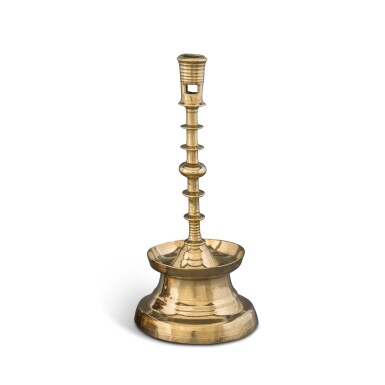A late 15th century carved and polychromed wood figural relief depicting the departure of the MagiFlemish or Lower Rhenish
The elaborately dressed kings all seated on horseback, their steeds with plumed bridles and bell hung tack, standing on a naturalistic humped base and raised on a later moulded rectangular plinth, 108cm high overall, 73cm wide and 24cm deepFootnotesProvenance
Purchased by St John Brodrick, Earl of Midleton.
Inherited by George Brodrick.
Thence by descent to the current owner, Sir Robert Corbett, KCVO,CB.
George St John Brodrick, 2nd Earl of Midleton purchased the present lot to form part of his extensive art collection in 1925. The piece was then inhereted by George Brodrick. He was educated first at Eton and then joined the Irish Guards from Cambridge. He served with distinction in Palestine before the onset of WWII and in the Norwegian campaign in the early days of the War. Here he was mentioned in despatches for gallant and distinguished conduct. He married Mhari Gourlay in the Guards Chapel in 1940. Retiring as a Captain and decorated with an MBE at the end of the War, he later moved to Dunley Manor in Hampshire. The Three Wise Men came here with him and stood in the hall until his death in 2003. When George Brodrick died in 2003, he left the statue to a close family and Irish Guards friend, Sir Robert Corbett, in his will.
It is interesting to note that throughout the late 15th century, works such as the present lot, were produced in large numbers for the open market. Subjects such as the Infancy of Christ or the Passion had the most 'mass appeal' so became a huge part of the fabric of artistic production in the Low Countries. Between 1380-1550 specifically, carved wooden altarpieces became a major art industry in the South Netherlands. With their rich polychrome, and heightened realism, for many they seemed to bridge the gap between sculpture and painting.
It was not until the late medieval period that the representation of one of the Magi as a Black King became more widespread. In the present lot, it is interesting that the Black Magus is leading the other Kings on their decorated steeds -typically in Adoration scenes, he would be furthest from Christ and not the most prominent (an example of this can be found in Jusutus of Ghent's Adoration scene (active ca. 1460-1480). Around the third century, writers interpreted the Magi as three kings based on the number of gifts they brought to the infant Christ. Later they were given the names Caspar, Melchior and Balthazar. It was in the eighth century that an author (only known as Pseudo Bede) spoke of a 'dark, fully bearded king called Balthazar'
Literature
P.Williamson, Netherlandish Sculpture, 1450-1550, V & A Publications, 2002.
L.F.Jacobs, Early Netherlandish Carved Altarpieces, 1380-1550 Medieval Tastes and Mass Marketing, Cambridge University Press, 1998.
A late 15th century carved and polychromed wood figural relief depicting the departure of the MagiFlemish or Lower Rhenish
The elaborately dressed kings all seated on horseback, their steeds with plumed bridles and bell hung tack, standing on a naturalistic humped base and raised on a later moulded rectangular plinth, 108cm high overall, 73cm wide and 24cm deepFootnotesProvenance
Purchased by St John Brodrick, Earl of Midleton.
Inherited by George Brodrick.
Thence by descent to the current owner, Sir Robert Corbett, KCVO,CB.
George St John Brodrick, 2nd Earl of Midleton purchased the present lot to form part of his extensive art collection in 1925. The piece was then inhereted by George Brodrick. He was educated first at Eton and then joined the Irish Guards from Cambridge. He served with distinction in Palestine before the onset of WWII and in the Norwegian campaign in the early days of the War. Here he was mentioned in despatches for gallant and distinguished conduct. He married Mhari Gourlay in the Guards Chapel in 1940. Retiring as a Captain and decorated with an MBE at the end of the War, he later moved to Dunley Manor in Hampshire. The Three Wise Men came here with him and stood in the hall until his death in 2003. When George Brodrick died in 2003, he left the statue to a close family and Irish Guards friend, Sir Robert Corbett, in his will.
It is interesting to note that throughout the late 15th century, works such as the present lot, were produced in large numbers for the open market. Subjects such as the Infancy of Christ or the Passion had the most 'mass appeal' so became a huge part of the fabric of artistic production in the Low Countries. Between 1380-1550 specifically, carved wooden altarpieces became a major art industry in the South Netherlands. With their rich polychrome, and heightened realism, for many they seemed to bridge the gap between sculpture and painting.
It was not until the late medieval period that the representation of one of the Magi as a Black King became more widespread. In the present lot, it is interesting that the Black Magus is leading the other Kings on their decorated steeds -typically in Adoration scenes, he would be furthest from Christ and not the most prominent (an example of this can be found in Jusutus of Ghent's Adoration scene (active ca. 1460-1480). Around the third century, writers interpreted the Magi as three kings based on the number of gifts they brought to the infant Christ. Later they were given the names Caspar, Melchior and Balthazar. It was in the eighth century that an author (only known as Pseudo Bede) spoke of a 'dark, fully bearded king called Balthazar'
Literature
P.Williamson, Netherlandish Sculpture, 1450-1550, V & A Publications, 2002.
L.F.Jacobs, Early Netherlandish Carved Altarpieces, 1380-1550 Medieval Tastes and Mass Marketing, Cambridge University Press, 1998.







.jpg)







Testen Sie LotSearch und seine Premium-Features 7 Tage - ohne Kosten!
Lassen Sie sich automatisch über neue Objekte in kommenden Auktionen benachrichtigen.
Suchauftrag anlegen